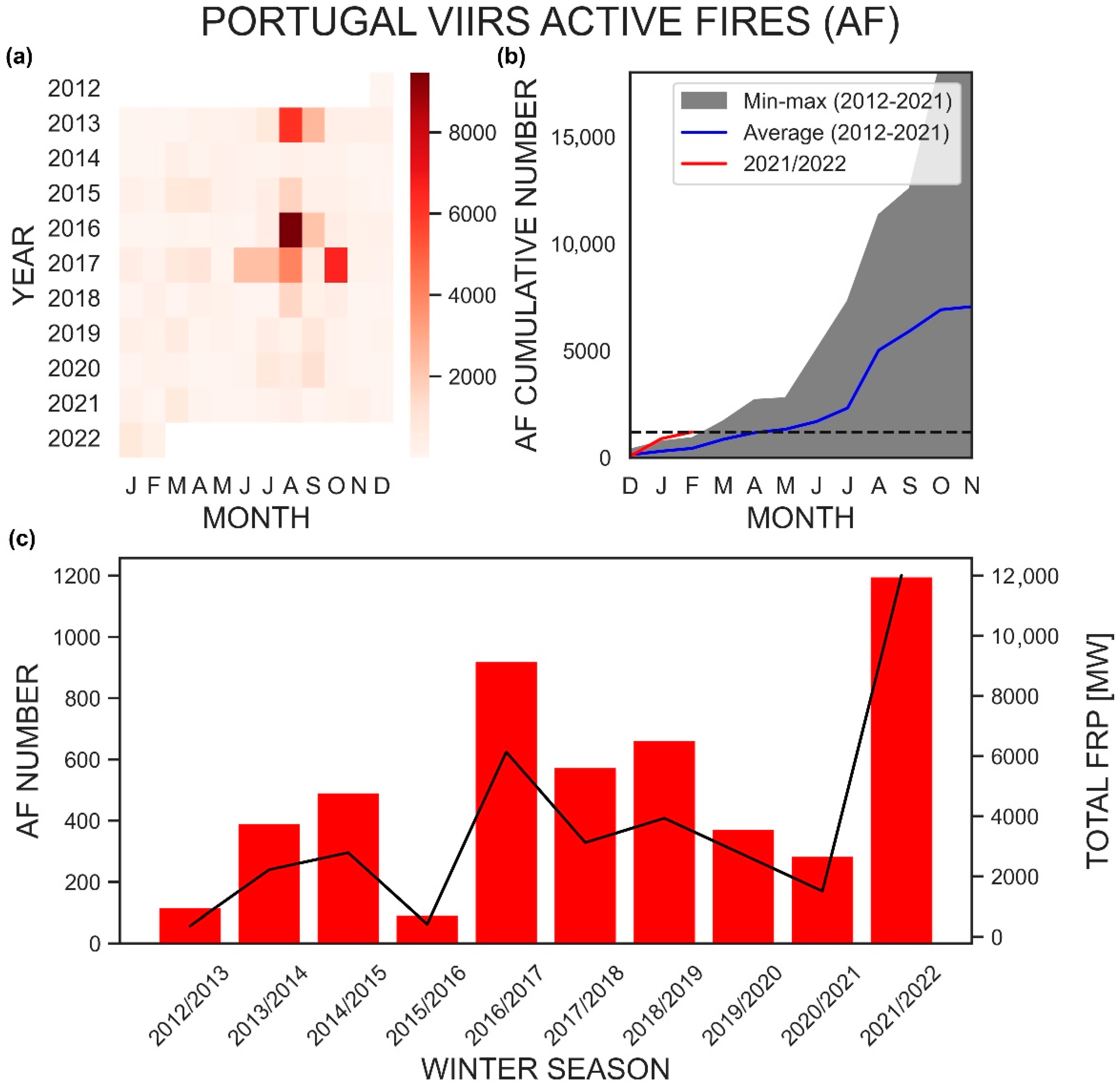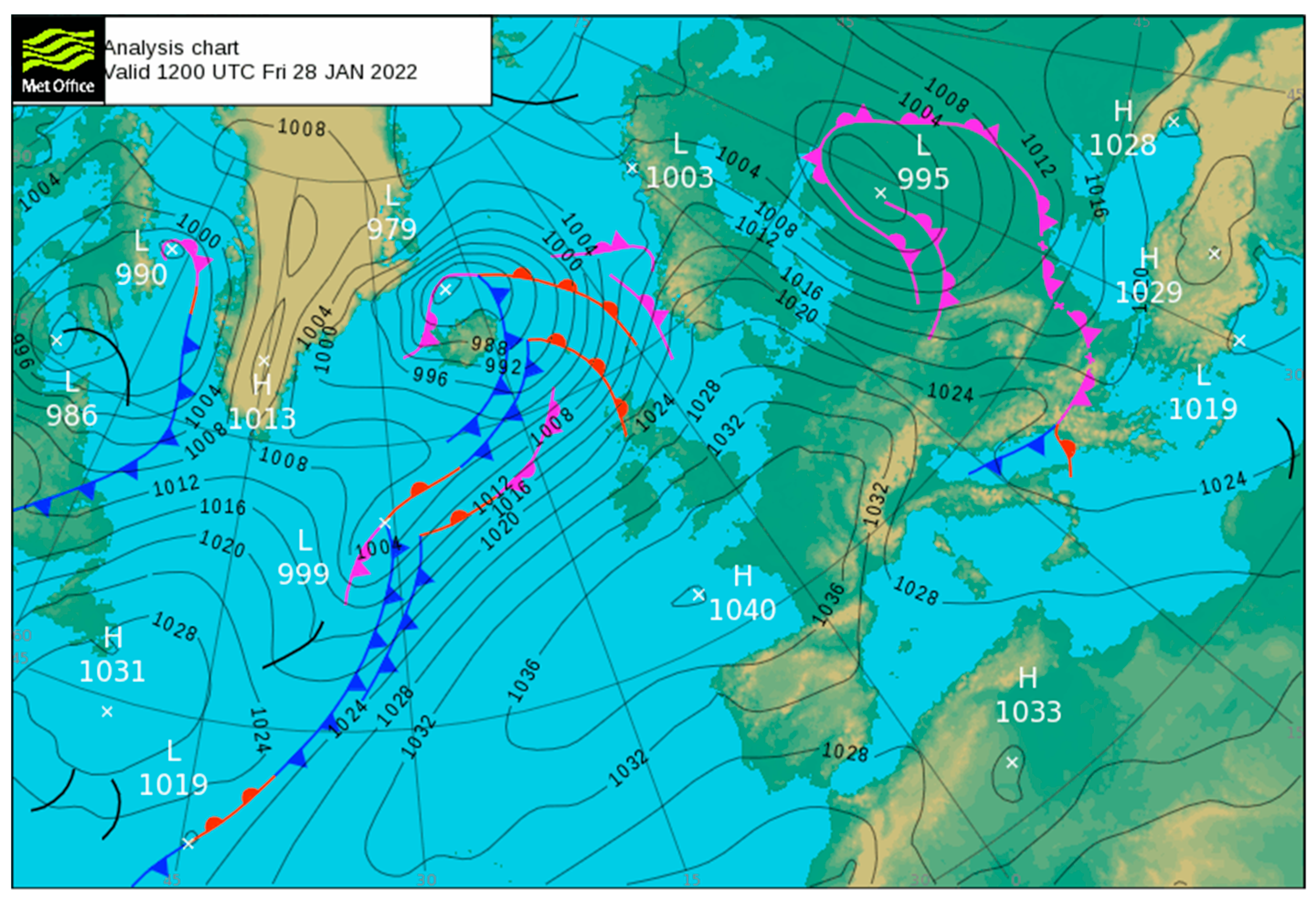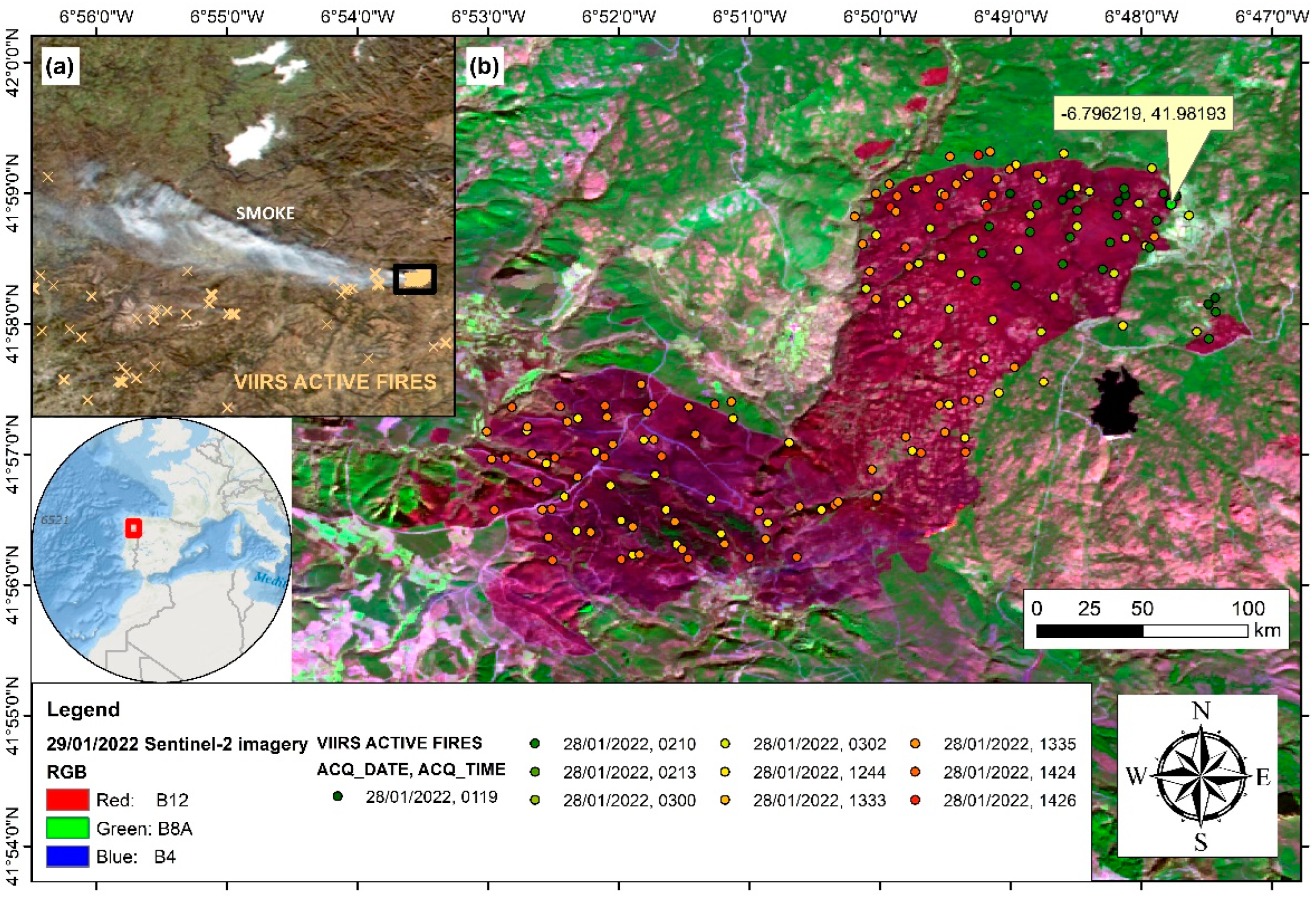Is Portugal Starting to Burn All Year Long? The Transboundary Fire in January 2022
Abstract
1. Introduction
2. Materials and Methods
2.1. Satellite Data (VIIRS 375 m Active Fire Product)
2.2. Case Study
2.3. Synoptic Charts and Weather Station Data
2.4. Numerical Experiment
3. Results and Discussion
3.1. Winter Fires in Portugal
3.2. Case Study: Fire Evolution and Atmospheric Conditions on 28 January 2022
4. Conclusions
Supplementary Materials
Author Contributions
Funding
Institutional Review Board Statement
Informed Consent Statement
Data Availability Statement
Acknowledgments
Conflicts of Interest
References
- Huss, M.; Hock, R. Global-scale hydrological response to future glacier mass loss. Nat. Clim. Chang. 2018, 8, 135–140. [Google Scholar] [CrossRef]
- Immerzeel, W.W.; Lutz, A.F.; Andrade, M.; Bahl, A.; Biemans, H.; Bolch, T.; Hyde, S.; Brumby, S.; Davies, B.J.; Elmore, A.C.; et al. Importance and vulnerability of the world’s water towers. Nature 2020, 577, 364–369. [Google Scholar] [CrossRef] [PubMed]
- Aubry-Wake, C.; Bertoncini, A.; Pomeroy, J.W. Fire and ice: The impact of wildfire-affected albedo and irradiance on glacier melt. Earth’s Future 2022, 10, e2022EF002685. [Google Scholar] [CrossRef]
- Adame, J.A.; Lope, L.; Hidalgo, P.J.; Sorribas, M.; Gutiérrez-Álvarez, I.; del Águila, A.; Saiz-Lopez, A.; Yela, M. Study of the exceptional meteorological conditions, trace gases and particulate matter measured during the 2017 forest fires in Doñana Natural Park, Spain. Sci. Total Environ. 2018, 645, 710–720. [Google Scholar] [CrossRef] [PubMed]
- Buchholz, R.R.; Park, M.; Worden, H.M.; Tang, W.; Edwards, D.P.; Gaubert, B.; Deeter, M.N.; Sullivan, T.; Ru, M.; Chin, M.; et al. New seasonal pattern of pollution emerges from changing North American wildfires. Nat. Commun. 2022, 13, 2043. [Google Scholar] [CrossRef]
- Dong, C.; Williams, A.P.; Abatzoglou, J.T.; Lin, K.; Okin, G.S.; Gillespie, T.W.; Long, D.; Lin, Y.-H.; Hall, A.; MacDonald, G.M. The season for large fires in Southern California is projected to lengthen in a changing climate. Commun. Earth Environ. 2022, 3, 22. [Google Scholar] [CrossRef]
- Dowdy, A.J. Climatological Variability of Fire Weather in Australia. J. Appl. Meteorol. Clim. 2018, 57, 221–234. [Google Scholar] [CrossRef]
- Collins, L.; Clarke, H.; Clarke, M.F.; McColl Gausden, S.C.; Nolan, R.H.; Penman, T.; Bradstock, R. Warmer and drier conditions have increased the potential for large and severe fire seasons across south-eastern Australia. Glob. Ecol. Biogeogr. 2022, 31, 1933–1948. [Google Scholar] [CrossRef]
- Carrillo, J.; Pérez, J.C.; Expósito, F.J.; Díaz, J.P.; González, A. Projections of wildfire weather danger in the Canary Islands. Sci. Rep. 2022, 12, 8093. [Google Scholar] [CrossRef]
- Libonati, R.; Geirinhas, J.L.; Silva, P.S.; Russo, A.; Rodrigues, J.A.; Belém, L.B.C.; Nogueira, J.; Roque, F.O.; DaCamara, C.C.; Nunes, A.M.B.; et al. Assessing the role of compound drought and heatwave events on unprecedented 2020 wildfires in the Pantanal. Environ. Res. Lett. 2022, 17, 015005. [Google Scholar] [CrossRef]
- Dacre, H.F.; Crawford, B.R.; Charlton-Perez, A.J.; Lopez-Saldana, G.; Griffiths, G.H.; Veloso, J.V. Chilean Wildfires: Probabilistic Prediction, Emergency Response, and Public Communication. Bull. Am. Meteorol. Soc. 2018, 99, 2259–2274. [Google Scholar] [CrossRef]
- Rodriguez, B.; Lareau, N.P.; Kingsmill, D.E.; Clements, C.B. Extreme pyroconvective updrafts during a megafire. Geophys. Res. Lett. 2020, 47, e2020GL089001. [Google Scholar] [CrossRef]
- Couto, F.T.; Iakunin, M.; Salgado, R.; Pinto, P.; Viegas, T.; Pinty, J.-P. Lightning modelling for the research of forest fire ignition in Portugal. Atmos. Res. 2020, 242, 104993. [Google Scholar] [CrossRef]
- Pinto, P.; Silva, Á.P.; Viegas, D.X.; Almeida, M.; Raposo, J.; Ribeiro, L.M. Influence of Convectively Driven Flows in the Course of a Large Fire in Portugal: The Case of Pedrógão Grande. Atmosphere 2022, 13, 414. [Google Scholar] [CrossRef]
- Couto, F.T.; Salgado, R.; Guiomar, N. Forest Fires in Madeira Island and the Fire Weather Created by Orographic Effects. Atmosphere 2021, 12, 827. [Google Scholar] [CrossRef]
- Purificação, C.; Andrade, N.; Potes, M.; Salgueiro, V.; Couto, F.T.; Salgado, R. Modelling the Atmospheric Environment Associated with a Wind-Driven Fire Event in Portugal. Atmosphere 2022, 13, 1124. [Google Scholar] [CrossRef]
- Sanders, D.; Laing, J. In the Line of Fire: The Challenges of Managing Tourism Operations in the Victorian Alps. Tour. Rev. Int. 2009, 13, 223–236. [Google Scholar] [CrossRef]
- Kim, M.-K.; Jakus, P.M. Wildfire, national park visitation, and changes in regional economic activity. J. Outdoor Recreat. Tour. 2019, 26, 34–42. [Google Scholar] [CrossRef]
- Couto, F.T.; Andrade, N.; Salgado, R.; Serra, J. Wildfire Risk in Madeira Island and the Potential Impacts on Tourism. In Proceedings of the EGU General Assembly 2021, Online, 19–30 April 2021; p. EGU21-14575. [Google Scholar] [CrossRef]
- Cioccio, L.; Michael, E.J. Hazard or disaster: Tourism management for the inevitable in Northeast Victoria. Tour. Manag. 2007, 28, 1–11. [Google Scholar] [CrossRef]
- Stoof, C.R.; Kettridge, N. Living with fire and the need for diversity. Earth’s Future 2022, 10, e2021EF002528. [Google Scholar] [CrossRef]
- Clarke, H.; Tran, B.; Boer, M.M.; Price, O.; Kenny, B.; Bradstock, R. Climate change effects on the frequency, seasonality and interannual variability of suitable prescribed burning weather conditions in southeastern Australia. Agric. For. Meteorol. 2019, 271, 148–157. [Google Scholar] [CrossRef]
- Arreola Amaya, M.; Clements, C.B. Evolution of Plume Core Structures and Turbulence during a Wildland Fire Experiment. Atmosphere 2020, 11, 842. [Google Scholar] [CrossRef]
- Bradstock, R.A.; Cary, G.J.; Davies, I.; Lindenmayer, D.B.; Price, O.F.; Williams, R.J. Wildfires, fuel treatment and risk mitigation in Australian eucalypt forests: Insights from landscape-scale simulation. J. Environ. Manag. 2012, 105, 66–75. [Google Scholar] [CrossRef] [PubMed]
- King, K.J.; Cary, G.J.; Bradstock, R.A.; Marsden-Smedley, J.B. Contrasting fire responses to climate and management: Insights from two Australian ecosystems. Glob. Chang. Biol. 2013, 19, 1223–1235. [Google Scholar] [CrossRef] [PubMed]
- Clarke, H.; Cirulis, B.; Penman, T.; Price, O.; Boer, M.M.; Bradstock, R. The 2019–2020 Australian forest fires are a harbinger of decreased prescribed burning effectiveness under rising extreme conditions. Sci. Rep. 2022, 12, 11871. [Google Scholar] [CrossRef] [PubMed]
- Abram, N.J.; Henley, B.J.; Sen Gupta, A.; Lippmann, T.J.R.; Clarke, H.; Dowdy, A.J.; Sharples, J.J.; Nolan, R.H.; Zhang, T.; Wooster, M.J.; et al. Connections of climate change and variability to large and extreme forest fires in southeast Australia. Commun Earth Environ. 2021, 2, 8. [Google Scholar] [CrossRef]
- Schroeder, W.; Oliva, P.; Giglio, L.; Csiszar, I.A. The New VIIRS 375 m active fire detection data product: Algorithm description and initial assessment. Remote Sens. Environ. 2014, 143, 85–96. [Google Scholar] [CrossRef]
- ICNF Report. 1 Relatório Provisório de Incêndios Rurais de 2022 (1 de Janeiro a 30 de Junho); Instituto da Conservação da Natureza e das Florestas, I.P., Departamento de Gestão de Áreas Públicas e de Proteção Florestal: Lisbon, Portugal, 2022; p. 14. Available online: https://www.icnf.pt/api/file/doc/1b241b838544443a (accessed on 30 August 2022).
- Met Office’s Website. Available online: https://digital.nmla.metoffice.gov.uk (accessed on 30 August 2022).
- IPMA’s Monthly Climate Bulletins. Available online: https://www.ipma.pt/pt/publicacoes/boletins.jsp?cmbDep=cli&cmbTema=pcl&cmbAno=2021&idDep=cli&idTema=pcl&curAno=2021 (accessed on 30 September 2022).
- Lac, C.; Chaboureau, J.P.; Masson, V.; Pinty, J.P.; Tulet, P.; Escobar, J.; Leriche, M.; Barthe, C.; Aouizerats, B.; Augros, C.; et al. Overview of the Meso-NH model version 5.4 and its applications. Geosci. Model Dev. 2018, 11, 1929–1969. [Google Scholar] [CrossRef]
- Pinty, J.-P.; Jabouille, P. A Mixed-Phase Cloud Parameterization for Use in Mesoscale Non-Hydrostatic Model: Simulations of a Squall Line and of Orographic Precipitation. In Proceedings of the Conference of Cloud Physics, Everett, WA, USA, 17–21 August 1998; pp. 217–220. [Google Scholar]
- Cuxart, J.; Bougeault, P.; Redelsperger, J.L. A turbulence scheme allowing for mesoscale and large-eddy simulations. Q. J. R. Meteorol. Soc. 2000, 126, 1–30. [Google Scholar] [CrossRef]
- Pergaud, J.; Masson, V.; Malardel, S.; Couvreux, F. A Parameterization of Dry Thermals and Shallow Cumuli for Mesoscale Numerical Weather Prediction. Bound. Layer Meteorol. 2009, 132, 83. [Google Scholar] [CrossRef]
- Mlawer, E.J.; Taubman, S.J.; Brown, P.D.; Iacono, M.J.; Clough, S.A. Radiative transfer for inhomogeneous atmospheres: RRTM, a validated correlated-k model for the longwave. J. Geophys. Res. 1997, 102, 16663–16682. [Google Scholar] [CrossRef]
- Masson, V.; Moigne, P.L.; Martin, E.; Faroux, S.; Alias, A.; Alkama, R.; Belamari, S.; Barbu, A.; Boone, A.; Bouyssel, F.; et al. The SURFEXv7.2 land and ocean surface platform for coupled or offline simulation of earth surface variables and fluxe. Geosci. Model Dev. 2013, 6, 929–960. [Google Scholar] [CrossRef]
- Filippi, J.; Bosseur, F.; Pialat, X.; Santoni, P.; Strada, S.; Mari, C. Simulation of Coupled Fire/Atmosphere Interaction with the MesoNH-ForeFire Models. J. Combust. 2011, 2011, 540309. [Google Scholar] [CrossRef]
- Filippi, J.B.; Bosseur, F.; Mari, C.; Lac, C. Simulation of a large wildfire in a coupled fire-atmosphere model. Atmosphere 2018, 9, 218. [Google Scholar] [CrossRef]
- Costes, A.; Rochoux, M.C.; Lac, C.; Masson, V. Subgrid-scale fire front reconstruction for ensemble coupled atmosphere-fire simulations of the FireFlux I experiment. Fire Saf. J. 2021, 126, 103475. [Google Scholar] [CrossRef]
- Couto, F.T.; Ducrocq, V.; Salgado, R.; Costa, M.J. Numerical simulations of significant orographic precipitation in Madeira island. Atmos. Res. 2016, 169, 102–112. [Google Scholar] [CrossRef]
- Iakunin, M.; Salgado, R.; Potes, M. Breeze Effects at a Large Artificial Lake: Summer Case Study. Hydrol. Earth Syst. Sci. 2018, 22, 5191–5210. [Google Scholar] [CrossRef]
- Akritidis, D.; Katragkou, E.; Georgoulias, A.K.; Zanis, P.; Kartsios, S.; Flemming, J.; Inness, A.; Douros, J.; Eskes, H. A complex aerosol transport event over Europe during the 2017 Storm Ophelia in CAMS forecast systems: Analysis and evaluation. Atmos. Chem. Phys. 2020, 20, 13557–13578. [Google Scholar] [CrossRef]
- Moore, D.P. The October 2017 red sun phenomenon over the UK. Weather 2019, 74, 348–353. [Google Scholar] [CrossRef]
- Moore, P. An analysis of storm Ophelia which struck Ireland on 16 October 2017. Weather 2021, 76, 301–306. [Google Scholar] [CrossRef]
- IPMA Report. Boletim Climático Portugal Continental, Janeiro 2022; Instituto Português do Mar e da Atmosfera, I.P. Divisão de Clima e Alterações Climáticas: Lisbon, Portugal, 2022; p. 16. Available online: https://www.ipma.pt/resources.www/docs/im.publicacoes/edicoes.online/20220204/FGdTvyAzNYKcsCOxBZMy/cli_20220101_20220131_pcl_mm_co_pt.pdf (accessed on 30 August 2022).
- Brewer, M.J.; Clements, C.B. The 2018 Camp Fire: Meteorological Analysis Using In Situ Observations and Numerical Simulations. Atmosphere 2020, 11, 47. [Google Scholar] [CrossRef]
- Kartsios, S.; Karacostas, T.; Pytharoulis, I.; Dimitrakopoulos, A.P. Numerical investigation of atmosphere-fire interactions during high-impact wildland fire events in Greece. Atmos. Res. 2021, 247, 105253. [Google Scholar] [CrossRef]
- Couto, F.T.; Ducrocq, V.; Salgado, R.; Costa, M.J. Understanding significant precipitation in Madeira island using high-resolution numerical simulations of real cases. Q. J. R. Meteorol. Soc. 2017, 143, 251–264. [Google Scholar] [CrossRef]





Publisher’s Note: MDPI stays neutral with regard to jurisdictional claims in published maps and institutional affiliations. |
© 2022 by the authors. Licensee MDPI, Basel, Switzerland. This article is an open access article distributed under the terms and conditions of the Creative Commons Attribution (CC BY) license (https://creativecommons.org/licenses/by/4.0/).
Share and Cite
Couto, F.T.; Santos, F.L.M.; Campos, C.; Andrade, N.; Purificação, C.; Salgado, R. Is Portugal Starting to Burn All Year Long? The Transboundary Fire in January 2022. Atmosphere 2022, 13, 1677. https://doi.org/10.3390/atmos13101677
Couto FT, Santos FLM, Campos C, Andrade N, Purificação C, Salgado R. Is Portugal Starting to Burn All Year Long? The Transboundary Fire in January 2022. Atmosphere. 2022; 13(10):1677. https://doi.org/10.3390/atmos13101677
Chicago/Turabian StyleCouto, Flavio T., Filippe L. M. Santos, Cátia Campos, Nuno Andrade, Carolina Purificação, and Rui Salgado. 2022. "Is Portugal Starting to Burn All Year Long? The Transboundary Fire in January 2022" Atmosphere 13, no. 10: 1677. https://doi.org/10.3390/atmos13101677
APA StyleCouto, F. T., Santos, F. L. M., Campos, C., Andrade, N., Purificação, C., & Salgado, R. (2022). Is Portugal Starting to Burn All Year Long? The Transboundary Fire in January 2022. Atmosphere, 13(10), 1677. https://doi.org/10.3390/atmos13101677









